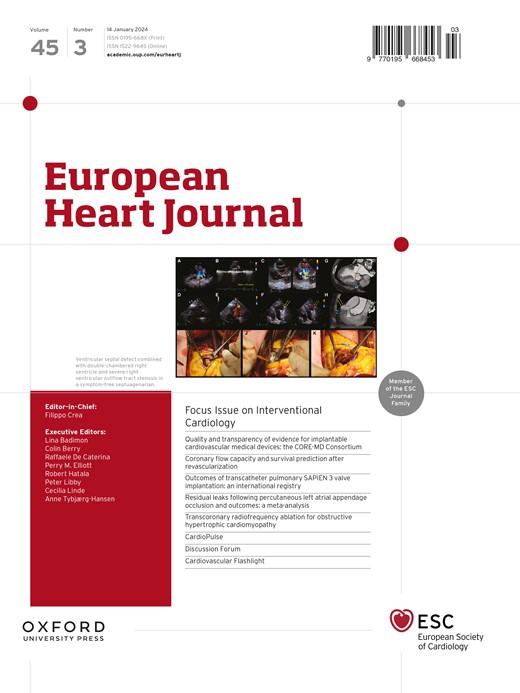Atrial amyloidosis identified by biopsy in atrial fibrillation: prevalence and clinical presentation.
IF 37.6
1区 医学
Q1 CARDIAC & CARDIOVASCULAR SYSTEMS
引用次数: 0
Abstract
BACKGROUND AND AIMS This study aimed to assess the prevalence of cardiac amyloidosis (CA) in patients with non-valvular atrial fibrillation (AF) and to test the hypothesis that early-stage CA can be identified through atrial biopsy. METHODS Atrial biopsy was performed on 578 patients during AF ablation, with right ventricular (RV) biopsy conducted in 385 patients. The amyloid type was assessed using immunohistochemistry. Patients were classified into groups of atrial biopsy-detected CA (abio-CA) and non-CA, with an additional 58 patients clinically diagnosed with CA comprising the clinical CA group. RESULTS Amyloid deposits were identified in atrial samples from 40 patients (7%), including 25 amyloid transthyretin (ATTR) types. Prevalence increased to 20%-40% with advancing age, left ventricular (LV) hypertrophy, and the presence of low-voltage areas in the left atrium. The abio-CA group exhibited a thinner LV posterior wall (11.3 ± 2.2 vs 15.3 ± 4.6 mm, P < .001) compared with the clinical CA group. The abio-CA group displayed a thicker LV posterior wall (11.3 ± 2.2 vs 9.6 ± 1.4 mm, P < .001) and a higher frequency of low-voltage areas defined as <0.5 mV (45% vs 13%, P < .001) compared with the non-CA group. Right ventricular biopsy identified amyloid deposits in 13 patients (3%), comprising 11 ATTR and 2 light-chain types. Among the 26 patients in the abio-CA group who underwent RV biopsy, 13 had no amyloid deposits in RV samples, indicating confined atrial amyloidosis. CONCLUSIONS Atrial biopsy revealed amyloid deposits in 7% of patients undergoing AF ablation, identifying early-stage CA.心房淀粉样变在房颤活检中鉴定:患病率和临床表现。
背景和目的本研究旨在评估心脏淀粉样变性(CA)在非瓣膜性心房颤动(AF)患者中的患病率,并验证早期CA可以通过心房活检识别的假设。方法对578例房颤消融患者行心房活检,其中385例行右心室活检。采用免疫组织化学方法评估淀粉样蛋白类型。患者被分为心房活检检测到的CA (abio-CA)组和非CA组,另外58例临床诊断为CA的患者组成临床CA组。结果40例(7%)患者心房标本中检出淀粉样蛋白沉积,包括25种淀粉样转甲状腺素(ATTR)型。随着年龄的增长、左心室肥厚和左心房低压区出现,患病率增加到20%-40%。与临床CA组相比,bio-CA组左室后壁较薄(11.3±2.2 vs 15.3±4.6 mm, P < 0.001)。与非ca组相比,abio-CA组左室后壁较厚(11.3±2.2 mm vs 9.6±1.4 mm, P < 0.001),定义为<0.5 mV的低压区频率较高(45% vs 13%, P < 0.001)。13例(3%)右心室活检发现淀粉样蛋白沉积,包括11例ATTR型和2例轻链型。abio-CA组26例患者行RV活检,13例RV标本未见淀粉样蛋白沉积,提示局限性心房淀粉样变性。结论:在接受房颤消融治疗的患者中,7%的患者活检显示淀粉样蛋白沉积,确定了早期CA。
本文章由计算机程序翻译,如有差异,请以英文原文为准。
求助全文
约1分钟内获得全文
求助全文
来源期刊

European Heart Journal
医学-心血管系统
CiteScore
39.30
自引率
6.90%
发文量
3942
审稿时长
1 months
期刊介绍:
The European Heart Journal is a renowned international journal that focuses on cardiovascular medicine. It is published weekly and is the official journal of the European Society of Cardiology. This peer-reviewed journal is committed to publishing high-quality clinical and scientific material pertaining to all aspects of cardiovascular medicine. It covers a diverse range of topics including research findings, technical evaluations, and reviews. Moreover, the journal serves as a platform for the exchange of information and discussions on various aspects of cardiovascular medicine, including educational matters.
In addition to original papers on cardiovascular medicine and surgery, the European Heart Journal also presents reviews, clinical perspectives, ESC Guidelines, and editorial articles that highlight recent advancements in cardiology. Additionally, the journal actively encourages readers to share their thoughts and opinions through correspondence.
 求助内容:
求助内容: 应助结果提醒方式:
应助结果提醒方式:


